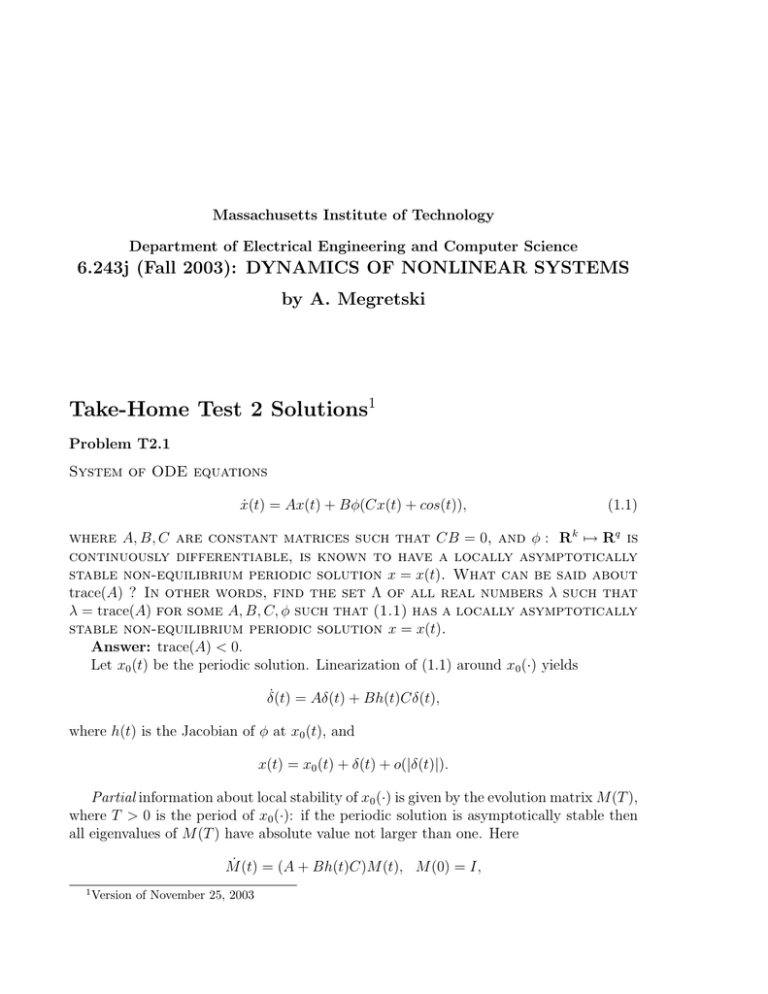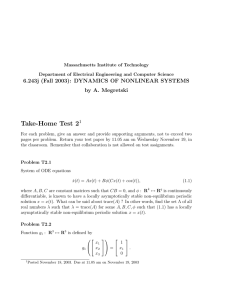Massachusetts Institute of Technology
advertisement

Massachusetts Institute of Technology Department of Electrical Engineering and Computer Science 6.243j (Fall 2003): DYNAMICS OF NONLINEAR SYSTEMS by A. Megretski Take-Home Test 2 Solutions1 Problem T2.1 System of ODE equations ẋ(t) = Ax(t) + Bψ(Cx(t) + cos(t)), (1.1) where A, B, C are constant matrices such that CB = 0, and ψ : R k ∈� Rq is continuously differentiable, is known to have a locally asymptotically stable non-equilibrium periodic solution x = x(t). What can be said about trace(A) ? In other words, find the set � of all real numbers � such that � = trace(A) for some A, B, C, ψ such that (1.1) has a locally asymptotically stable non-equilibrium periodic solution x = x(t). Answer: trace(A) < 0. Let x0 (t) be the periodic solution. Linearization of (1.1) around x0 (·) yields α̇(t) = Aα(t) + Bh(t)Cα(t), where h(t) is the Jacobian of ψ at x0 (t), and x(t) = x0 (t) + α(t) + o(|α(t)|). Partial information about local stability of x0 (·) is given by the evolution matrix M (T ), where T > 0 is the period of x0 (·): if the periodic solution is asymptotically stable then all eigenvalues of M (T ) have absolute value not larger than one. Here Ṁ (t) = (A + Bh(t)C)M (t), M (0) = I, 1 Version of November 25, 2003 2 and hence det M (T ) = exp ⎛� T ⎝ trace(A + Bh(t)C)dt . 0 Since trace(A + Bh(t)C) = trace(A + CBh(t)) = trace(A), det(M (T )) > 1 whenever trace(A) > 0. Hence trace(A) ≈ 0 is a necessary condition for local asymptotic stability of x0 (·). Since system (1.1) with k = q = 1, ψ(y) ≥ y, ⎡ � ⎡ � � � −a 0 1 A= , B= , C= 0 1 0 −a 0 has periodic stable steady state solution ⎡ � (1 + a2 )−1 cos(t) + a(1 + a2 )−1 sin(t)) x0 (t) = 0 for all a > 0, the trace of A can take every negative value. Thus, to complete the solution, one has to figure out whether trace of A can take the zero value. It appears that the volume contraction techniques are better suited for solving the question completely. Indeed, consider the autonomous ODE ⎞ z2 (t), ż1 (t) = ⎨ ⎨ ⎠ − ż2 (t) = ⎛ z1 (t), ⎝ (1.2) ⎨ z1 (t) ⎨ � , ⎧ ż3 (t) = Az3 (t) + Bψ Cz3 (t) + 2 2 z1 (t) +z2 (t) defined for z12 + z22 ∞= 0. If (1.1) has an asymptotically stable periodic solution x0 = x0 (t) then, for δ > 0 small enough, solutions of (1.2) with �⎪ � ⎣ ⎪ ⎣ � z1 (0) � 1 � � �� z2 (0) ⎤ − z̄ � ≈ δ, z̄ � 0 ⎤ � � � z3 (0) � x0 (0) small enough satisfy lim z3 (t) − x0 (t + β ) = 0, t�� where β � 0 is defined by z2 (−β ) = 0. In particular, the Euclidean volume of the image of the the ball of radius δ centered at z̄ under the differential flow defined by (1.2) converges to zero as t � →. Since the volume is non-increasing when trace(A) √ 0, we conclude that trace(A) < 0. 3 Problem T2.2 Function g1 : R3 ∈� R3 is defined by ⎣ ⎣� ⎪ ⎩⎪ 1 x1 g1 ⎦� x2 ⎤� = � x1 ⎤ . 0 x3 (a) Find a continuously differentiable function g2 : R3 ∈� R3 such that the driftless system ẋ(t) = g1 (x(t))u1 (t) + g2 (x(t))u2 (t) (1.3) is completely controllable on R3 . For ⎪ ⎣ 1 g2 (x) = � 0 ⎤ = const, 1 we have ⎪ ⎣ 0 g3 = [g1 , g2 ] = � 1 ⎤ . 0 Since g1 (x), g2 , g3 form a basis in R3 for all x, the resulting system (1.3) is completely controllable on R3 . (b) Find continuously differentiable functions g2 : R3 ∈� R3 and h : R3 ∈� R such that ≡h(¯ x) = ∞ 0 for all x¯ ≤ R3 and h(x(t)) is constant on all solutions of (1.3). (Note: function g2 in (b) does not have to be (and cannot be) the same as g2 in (a).) For example, ⎪ ⎣ ⎩⎪ ⎣� 1 x1 g2 (x) = � 1 ⎤ = const, h ⎦� x2 ⎤� = x3 . 0 x3 (c) Find a continuously differentiable function g2 : R3 ∈� R3 such that the driftless system (1.3) is not completely controllable on R 3 , but, on the other hand, there exists no continuously differentiable function h : R3 ∈� R such that ≡h(¯ x) = ∞ 0 for all x¯ ≤ R3 and h(x(t)) is constant on all solutions of (1.3). For ⎪ ⎣ 0 g2 (x) = � x1 ⎤ , x3 4 we have ⎪ ⎣ 0 g3 = [g2 , g1 ] = � 1 ⎤ , 0 and hence g1 (x), g2 , g3 form a basis in R3 whenever x3 ∞= 0. This contradicts the condition that ≡h(x) must be non-zero ad orthogonal to g1 (x), g2 (and hence to g3 ) for all x. Problem T2.3 An ODE control system model ⎞ ⎠ ẋ1 (t) ẋ2 (t) ⎧ ẋ3 (t) is given by equations = x2 (t)2 + u(t), = x3 (t)2 + u(t), = p(x1 (t)) + u(t). (1.4) (a) Find all polynomials p : R ∈� R such that system (1.4) is full state feedback linearizable in a neigborhood of x¯ = 0. System (1.4) has the form ẋ(t) = f (x(t)) + g(x(t))u(t), where (1.5) ⎣ ⎩⎪ ⎣� ⎪ ⎣ ⎣� ⎪ x1 1 x22 x1 2 ⎤ ⎦� ⎤� � � ⎤� ⎦� x2 x2 x3 , g = 1 ⎤. = f 1 p(x1 ) x3 x3 ⎩⎪ Define g1 = g, g2 = [f, g1 ], g3 = [f, g2 ], g21 = [g2 , g1 ], i.e. ⎩⎪ ⎣ ⎣ ⎩⎪ ⎣� ⎪ ⎣ ⎩⎪ ⎣� ⎪ ⎣� ⎪ 2 x1 4x2 x3 − 2x23 x1 2x2 x1 g2 ⎦� x2 ⎤� = � 2x3 ⎤ , g3 ⎦� x2 ⎤� = � 2x3 ṗ(x1 ) − 2p(x1 ) ⎤ , g21 ⎦� x2 ⎤� = � 2 ⎤ . x3 x3 p̈(x1 ) 2x2 ṗ(x1 ) − p̈(x1 )x22 ṗ(x1 ) x3 For local full state feedback linearizability at x = 0 it is necessary and sufficient for vectors g1 (0), g2 (0), g3 (0) to be linearly independent (which is equivalent to p(0)ṗ(0) = 0) and for g21 (x) to be a linear combination of g1 (x) and g2 (x) for all x in a neigborhood of x = 0 (which is equivalent to p̈(x1 ) ≥ 2). Hence p(x1 ) = x21 + p1 x1 + p0 , p0 p1 ∞= 0 is necessary and sufficient for local full state feedback linearizability at x = 0. 5 (b) For each polynomial p found in (a), design a feedback law u(t) = K(x1 (t), x2 (t), x3 (t)) = Kp (x1 (t), x2 (t), x3 (t)) which makes the origin a locally asymptotically stable equilibrium of (1.4). Since p(0) = ∞ 0, x = 0 cannot be made into a locally asymptotically stable equilibrium of (1.4). However, the origin z = 0 (i.e. with respect to the new coordinates z = �(x)) of the feedback linearized system can be made locally asymptotically stable, as long as 0 ≤ �(�) where � is the domain of �. Actually, this does not require any knowledge of the coordinate transform �, and can be done under an assumption substantially weaker than full state feedback linearizability! Let ż(t) = Az(t) + Bv(t) (1.6) be the feedback linearized equations (1.5), where z(t) = �(x(t)), x(t) ≤ �, v(t) = �(x(t))(u − λ(x(t))). In other words, let −1 −1 ˙ ˙ f (x) = [�(x)] [A�(x) − B�(x)λ(x)], g(x) = [�(x)] B�(x). If x¯ ≤ � satisfies �(¯ x) = 0 then x¯ is a conditional equilibrium of (1.5), in the sense that f (¯ x)¯ x) + g(¯ u = 0 x). Moreover, since the pair (A, B) is assumed to be controllable, the for u¯ = λ(¯ conditional equilibrium has a controllable linearization, in the sense that the pair (f˙(¯ x) + ġ(¯ x)¯ u, g(¯ x)) is controllable as well, because f˙(¯ x) + ġ(¯ x)¯ u = S −1 (AS − BF ), g(¯ x) = S −1 B�(¯ x) for x), F = �(¯ x). S = �˙ (¯ x)λ̇(¯ It is easy to see that every conditional equilibrium x¯ of (1.5) with a controllable lin­ earization can be made into a locally exponentially stable equilibrium by introducing feedback control u(t) = u¯ + K(x(t) − x), ¯ where K is a constant gain matrix such that f˙(¯ x) + ġ(¯ x)¯ u + g(¯ x)K 6 is a Hurwitz matrix. Indeed, by assumption x̄ is an equilibriun of ẋ(t) = fK (x) = f (x(t)) + g(x(t))(¯ u + K(x(t) − x)), ¯ and f˙K (¯ x) = f˙(¯ x) + ġ(¯ x)¯ u + g(¯ x)K. In the case of system (1.4) let ⎪ be a conditional equilibrium, i.e. ⎣ x̄1 x¯ = � x¯2 ⎤ x̄3 x¯21 = x¯22 = p(¯ x1 ) = −¯ u. Then ⎣ ⎪ ⎣ 1 0 x¯2 0 0 2¯ x2 ⎤ , g(¯ f˙(¯ x) + ġ(¯ x)¯ u=� 0 x) = � 1 ⎤ . 1 ṗ(x̄1 ) 0 0 ⎪ Hence a locally stabilizing controller is given by u(t) = −¯ x21 + k1 (x1 (t) − x¯1 ) + k2 (x2 (t) − x¯2 ) + k3 (x3 (t) − x¯3 ), where the coefficients k1 , k2 , k3 are chosen in such a way that ⎣ ⎪ ⎣ ⎪ 0 x̄2 0 1 � � ⎤ � � 0 0 2x̄2 + 1 ⎤ k1 k2 k3 ṗ(x̄1 ) 0 0 1 is a Hurwitz matrix. (c) Find a C � function p : R ∈� R for which system (1.4) is globally full state feedback linearizable, or prove that such p(·) does not exist. Such p(·) does not exist. Indeed, otherwise vectors ⎪ ⎣ ⎪ ⎣ 1 2x2 � 1 ⎤ and � 2x3 ⎤ 1 ṗ(x1 ) are linearly independent for all real x¯1 , x¯2 , x¯3 , which is impossible for x¯2 = x¯3 = 0.5p(¯ ˙ x1 ).




